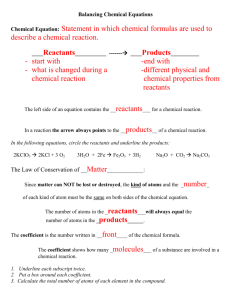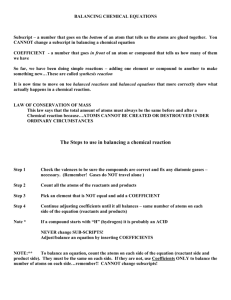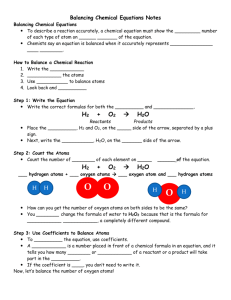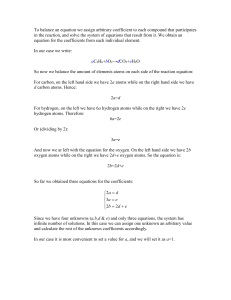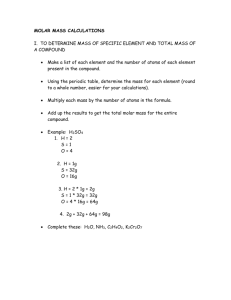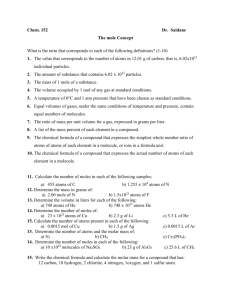printer-friendly sample test questions
advertisement
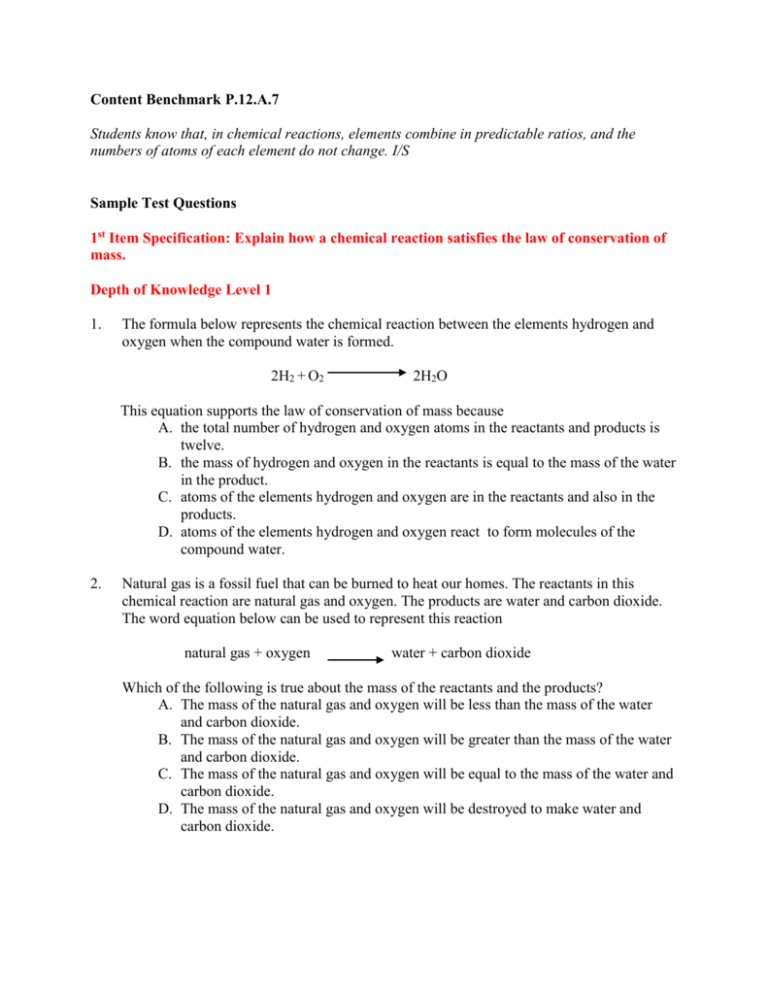
Content Benchmark P.12.A.7 Students know that, in chemical reactions, elements combine in predictable ratios, and the numbers of atoms of each element do not change. I/S Sample Test Questions 1st Item Specification: Explain how a chemical reaction satisfies the law of conservation of mass. Depth of Knowledge Level 1 1. The formula below represents the chemical reaction between the elements hydrogen and oxygen when the compound water is formed. 2H2 + O2 2H2O This equation supports the law of conservation of mass because A. the total number of hydrogen and oxygen atoms in the reactants and products is twelve. B. the mass of hydrogen and oxygen in the reactants is equal to the mass of the water in the product. C. atoms of the elements hydrogen and oxygen are in the reactants and also in the products. D. atoms of the elements hydrogen and oxygen react to form molecules of the compound water. 2. Natural gas is a fossil fuel that can be burned to heat our homes. The reactants in this chemical reaction are natural gas and oxygen. The products are water and carbon dioxide. The word equation below can be used to represent this reaction natural gas + oxygen water + carbon dioxide Which of the following is true about the mass of the reactants and the products? A. The mass of the natural gas and oxygen will be less than the mass of the water and carbon dioxide. B. The mass of the natural gas and oxygen will be greater than the mass of the water and carbon dioxide. C. The mass of the natural gas and oxygen will be equal to the mass of the water and carbon dioxide. D. The mass of the natural gas and oxygen will be destroyed to make water and carbon dioxide. Depth of Knowledge Level 2 3. The equation representing the formation of water from oxygen and hydrogen is 2H2 + O2 2H2O. In this reaction 32 grams of oxygen react with 4 grams of hydrogen to from two molecules of water. The law of conservation of mass is supported by the formation of water from hydrogen and oxygen because A. 2 hydrogen atoms react with 2 oxygen atoms to form 2 water molecules. B. 32 grams of oxygen and 4 grams of hydrogen will produce 36 grams of water. C. the volume of the oxygen and hydrogen will equal the volume of the water. D. the size of the hydrogen and oxygen atoms and the water molecule will be equal. 4. Analyze the table below. The following symbols each represent one atom of different elements: Reactants I + II + III IV + + Products + + + Which of the above correctly represents a chemical equation showing the law of conservation of mass in a chemical reaction? A. I B. II C. III D. IV 2nd Item Specification: Balance simple chemical reaction equations using simple whole number ratios and the conservation of mass principle. Depth of Knowledge Level 1 5. The following equation can be used to represent the formation of carbon monoxide from carbon and oxygen 2C + O2 2CO The reaction supports the conservation of mass principle because the A. mass of the carbon and oxygen atoms are the same before and after the reaction. B. the oxygen atoms are bigger than the carbon atoms before and after the reaction. C. the carbon and oxygen atoms are the same shape before and after the reaction. D. the carbon atoms are the same size as the oxygen atoms during the reaction. 6. Identify the balanced equation that supports the law of conservation of mass. A. H2 + O2 2H2O B. 2H2 + 2O2 2H2O C. 2H2 + O2 2H2O D. H2 + 2O2 2H2O Depth of Knowledge Level 2 7. The following equation for the photosynthesis reaction is unbalanced. 6CO2 + H2O C6H12O6 + 6O2 Which equation is balanced and shows conservation of mass? A. CO2 + H2O C6H12O6 + O2 8. B. CO2 + 2H2O 2C6H12O6 + 2O2 C. 6CO2 + 6H2O C6H12O6 + 6O2 D. 6CO2 + H2O C6H12O6 + 6O2 The following equation represents the reaction between iron (Fe) and oxygen (O) to form iron oxide (Fe2O3). 4Fe + 3O2 2Fe2O3 This equation supports the conservation of mass principle because there are A. 10 total iron and oxygen atoms involved in the reaction. B. 20 total iron and oxygen atoms involved in the reaction. C. 4 iron atoms and 3 oxygen atoms before and after the reaction. D. 4 iron atoms and 6 oxygen atoms before and after the reaction. 9. The following equation for the rusting of iron is missing the coefficients representing the correct number of iron atoms and oxygen atoms in the reactants. Fe + O2 2Fe2O3 Identify the number of iron and oxygen atoms in the reactants that will balance the equation. A. Four iron atoms and four oxygen atoms. B. Four iron atoms and six oxygen atoms. C. Two iron atoms and two oxygen atoms. D. Two iron atoms and three oxygen atoms. 3rd Item Specification: Explain that the law of definite proportions allows for predictions of reaction amounts. Depth of Knowledge Level 1 10. The compound water is represented by the formula H2O. Water is the only compound with this formula because A. only water contains atoms of the elements hydrogen and oxygen. B. atoms of hydrogen and oxygen are identical to each other in a reaction. C. atoms can never be created or destroyed by physical or chemical reactions. D. a specific compound always has the same relative numbers and kinds of atoms. 11. Which of the following is true about the law of definite proportions? A. The elements hydrogen (H) and oxygen (O) will always react to form the compound water (H2O). B. The compound water (H2O) will always contain the elements hydrogen (H) and oxygen (O) in the same proportions. C. The mass of water (H2O) will always equal the mass of the hydrogen (H) and oxygen (O) from which it is made. D. The element hydrogen (H) will always be heavier then the element oxygen (O) in the compound water (H2O). Depth of Knowledge Level 2 12. A chemistry student determined the amount of carbon in 100 grams of carbon dioxide to be 27.3 percent. According the law of definite proportions, which of the following statements is true about the amount of carbon in a second 100 gram sample of carbon dioxide? A. The amount of carbon in the second sample can be predicted to be 27.3 percent. B. The amount of carbon in the second sample can be predicted to be 100 grams. C. The amount of carbon in the second sample will be less than in the first sample. D. The amount of carbon in the second sample will be more than in the first sample. 13. The mass of water is always 88.9 percent oxygen and 11.1 percent hydrogen. Which of the following is true about the amount of oxygen in 100 g of water compared to the amount of oxygen in 200 g of water? A. 100 g of water will contain a lower percentage of oxygen than 200 g of water. B. 100 g of water will contain 88.9 percent oxygen and 200 g of water will contain 177.8 percent oxygen. C. 100 g of water will contain 88.9 percent oxygen and 200 g of water will contain 88.9 percent of oxygen. D. 100 g of water will contain 88.9 g of oxygen and 200 g of water will contain 88.9 g of oxygen. 14. Calcium carbonate is a compound in the rock marble. Analyze the following table showing the composition of calcium carbonate. Calcium Carbonate Element Mass Percent (%) Oxygen 48 Calcium 40 Carbon 12 Which of the following statements is true about the amount of carbon in a 100 g sample of calcium carbonate? A. The sample will contain 12 g of carbon and will be 12% carbon. B. The sample will contain 12 g of carbon and will be 24% carbon. C. The sample will contain 24 g of carbon and will be 12% carbon. D. The sample will contain 24 g of carbon and will be 24% carbon. Content Benchmark P.12.A.7 Students know that, in chemical reactions, elements combine in predictable ratios, and the numbers of atoms of each element do not change. I/S Answers to Sample Test Questions 1. 2. 3. 4. 5. 6. 7. 8. 9. 10. 11. 12. 13. 14. B, C, B, B, A, C, C, D, B, D, B, A, C, A, DOK level 1 DOK level 1 DOK level 2 DOK level 2 DOK level 1 DOK level 1 DOK level 2 DOK level 2 DOK level 2 DOK level 2 DOK level 1 DOK level 2 DOK level 2 DOK level 2

